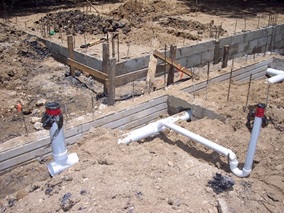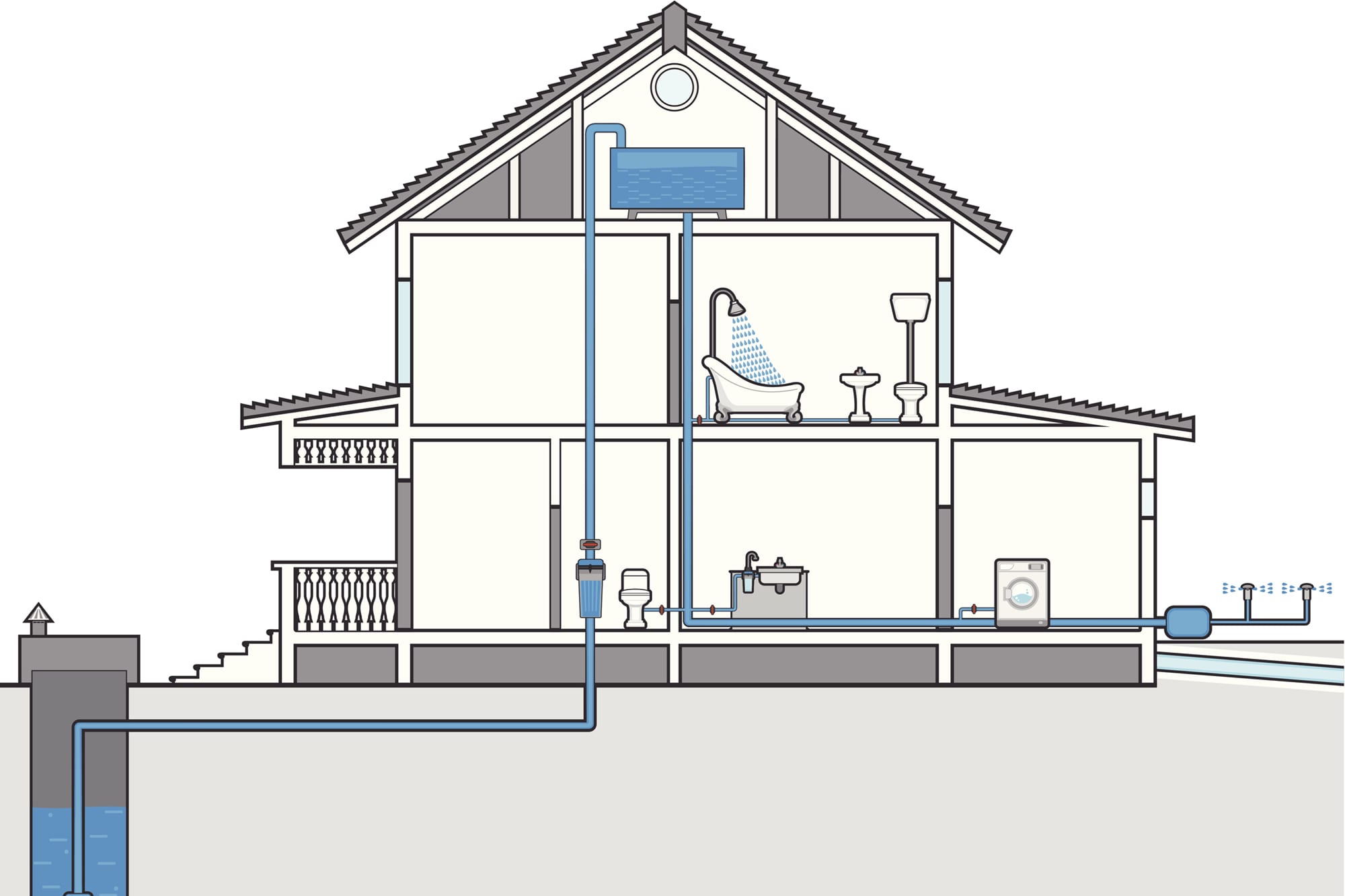The Layout of Your Home's Plumbing System Explained
The Layout of Your Home's Plumbing System Explained
Blog Article
This post down the page about Anatomy of a House: Understanding the Components is truly stimulating. Give it a try and draw your own personal final thoughts.

Recognizing just how your home's pipes system functions is vital for each home owner. From providing tidy water for drinking, cooking, and bathing to safely eliminating wastewater, a properly maintained pipes system is vital for your family's health and comfort. In this thorough guide, we'll explore the elaborate network that makes up your home's plumbing and deal tips on upkeep, upgrades, and taking care of common concerns.
Intro
Your home's pipes system is greater than simply a network of pipes; it's a complicated system that ensures you have access to clean water and efficient wastewater elimination. Understanding its components and just how they collaborate can assist you stop expensive repair work and ensure every little thing runs efficiently.
Basic Elements of a Pipes System
Pipes and Tubes
At the heart of your plumbing system are the pipes and tubing that carry water throughout your home. These can be constructed from different materials such as copper, PVC, or PEX, each with its advantages in regards to sturdiness and cost-effectiveness.
Fixtures: Sinks, Toilets, Showers, etc.
Components like sinks, commodes, showers, and bath tubs are where water is utilized in your house. Comprehending how these components link to the pipes system helps in detecting problems and planning upgrades.
Shutoffs and Shut-off Points
Valves regulate the circulation of water in your plumbing system. Shut-off valves are critical throughout emergencies or when you require to make repair work, allowing you to isolate parts of the system without interfering with water circulation to the entire residence.
Water System System
Key Water Line
The primary water line attaches your home to the local water supply or a personal well. It's where water enters your home and is dispersed to various fixtures.
Water Meter and Stress Regulatory Authority
The water meter steps your water use, while a pressure regulator makes sure that water streams at a secure pressure throughout your home's plumbing system, stopping damages to pipelines and fixtures.
Cold Water vs. Hot Water Lines
Comprehending the difference in between cold water lines, which provide water directly from the primary, and hot water lines, which bring warmed water from the hot water heater, assists in troubleshooting and preparing for upgrades.
Drainage System
Drain Pipes Pipeline and Traps
Drain pipelines bring wastewater far from sinks, showers, and toilets to the drain or sewage-disposal tank. Catches avoid sewage system gases from entering your home and additionally trap particles that might cause clogs.
Air flow Pipes
Ventilation pipelines enable air right into the water drainage system, avoiding suction that could slow drainage and cause traps to empty. Proper ventilation is essential for maintaining the honesty of your plumbing system.
Relevance of Proper Drain
Guaranteeing correct water drainage protects against backups and water damages. Frequently cleaning up drains pipes and maintaining catches can avoid expensive repairs and expand the life of your plumbing system.
Water Furnace
Kinds Of Water Heaters
Hot water heater can be tankless or conventional tank-style. Tankless heating units warmth water as needed, while storage tanks save heated water for instant use.
Exactly How Water Heaters Connect to the Pipes System
Understanding exactly how hot water heater connect to both the cold water supply and warm water circulation lines aids in detecting problems like inadequate warm water or leaks.
Upkeep Tips for Water Heaters
On a regular basis flushing your water heater to get rid of sediment, checking the temperature level setups, and inspecting for leakages can extend its life-span and enhance energy efficiency.
Usual Pipes Problems
Leakages and Their Reasons
Leaks can occur due to maturing pipelines, loose installations, or high water stress. Addressing leakages quickly stops water damage and mold growth.
Clogs and Clogs
Obstructions in drains pipes and commodes are usually brought on by purging non-flushable products or a buildup of grease and hair. Using drain displays and being mindful of what goes down your drains can prevent blockages.
Indications of Plumbing Troubles to Expect
Low water pressure, slow drains, foul odors, or unusually high water bills are signs of potential plumbing troubles that need to be resolved without delay.
Pipes Upkeep Tips
Normal Examinations and Checks
Arrange annual plumbing evaluations to catch issues early. Seek indicators of leakages, deterioration, or mineral accumulation in taps and showerheads.
Do It Yourself Upkeep Tasks
Straightforward tasks like cleaning faucet aerators, checking for toilet leakages making use of color tablets, or protecting exposed pipes in cold environments can avoid significant pipes concerns.
When to Call an Expert Plumbing Technician
Know when a plumbing issue requires expert competence. Attempting intricate repair services without appropriate knowledge can lead to even more damages and higher fixing expenses.
Upgrading Your Pipes System
Factors for Updating
Updating to water-efficient components or changing old pipelines can enhance water high quality, decrease water expenses, and increase the worth of your home.
Modern Plumbing Technologies and Their Benefits
Explore innovations like smart leakage detectors, water-saving commodes, and energy-efficient water heaters that can save cash and decrease environmental influence.
Expense Considerations and ROI
Compute the in advance costs versus lasting savings when thinking about pipes upgrades. Lots of upgrades pay for themselves via decreased energy expenses and less fixings.
Ecological Effect and Conservation
Water-Saving Fixtures and Devices
Mounting low-flow taps, showerheads, and toilets can dramatically minimize water usage without sacrificing efficiency.
Tips for Minimizing Water Usage
Straightforward routines like fixing leakages immediately, taking shorter showers, and running full lots of laundry and dishes can preserve water and lower your energy expenses.
Eco-Friendly Plumbing Options
Take into consideration sustainable pipes materials like bamboo for floor covering, which is durable and eco-friendly, or recycled glass for counter tops.
Emergency situation Preparedness
Steps to Take Throughout a Plumbing Emergency situation
Know where your shut-off shutoffs are located and exactly how to switch off the water supply in case of a ruptured pipeline or major leakage.
Relevance of Having Emergency Get In Touches With Convenient
Keep get in touch with details for local plumbing professionals or emergency services conveniently offered for fast response during a pipes crisis.
DIY Emergency Situation Fixes (When Relevant).
Short-lived fixes like utilizing air duct tape to spot a leaking pipe or putting a pail under a dripping tap can decrease damages until an expert plumbing technician gets here.
Conclusion.
Comprehending the anatomy of your home's plumbing system equips you to keep it properly, saving time and money on fixings. By following normal upkeep regimens and remaining notified about modern plumbing modern technologies, you can guarantee your plumbing system operates efficiently for years to find.
HOW YOUR PLUMBING SYSTEM WORKS
Which Pipes Do What?
Blue lines = fresh water supply entering the building
Red lines = hot water supply entering the building
Grey lines = pipes carrying waste away from the building and venting pipes carrying gases away from the building (through the roof)
YOUR MAIN PLUMBING SYSTEMS
There are two main plumbing systems that support your home s basic plumbing needs one that brings clean water into your home, and one that sends dirty water away from your home. Connected to the toilet, bath, shower, and other faucets in your home, these two systems keep your water flowing in the right directions.
ACCESSING FRESH WATER
Fresh and clean water is brought into your home through the main water supply line . Filtered through one pipe, this water is pressured to flow into the various fixtures in your home at any given time.
This water can be sourced from a well located on your property, a pond or river (mostly cottages), or, as in most cases, from the city s municipal water treatment centre. However, it is important to note that water that is untreated, such as the water siphoned from ponds or rivers, may not be safe to drink. Personal water supplies always need to be treated for hardness and contaminants before consumed.
MUNICIPAL WATER SUPPLIES
Improve taste and odour
Remove sediment
Eliminate hardness
Reduce chlorine
COLD WATER SUPPLY VS. HOT WATER SUPPLY
Cold water flows into your home or building through the service line, which then distributes hot or cold water to your fixtures. This line is most commonly run through a central column that runs floor to floor. Hot water runs in short and straight pipes as the longer the pipeline, the more heat that will be lost in the transfer. Having shorter pipes also allows residents to access hot water more quickly.
WASTE WATER SYSTEM
Your wastewater system is divided into two parts pipes that send wastewater away from your home and venting pipes that send sewer gas away from your home. Sewage water travels through pipes that flush the water and waste towards local sewers that are operated and managed by your city or town. Most sewer systems rely on gravity to move the wastewater to where it needs to go.
The further away from your toilet or sink, the larger wastewater pipes become. This allows for waste to be disposed of from various parts of your home or business at once without pipe blockages. The angle and flow of these pipes are also essential for keeping your waste pipes clear of build up.
https://harrisplumbing.ca/how-your-home-plumbing-system-works/

HOW YOUR PLUMBING SYSTEM WORKS
Which Pipes Do What?
YOUR MAIN PLUMBING SYSTEMS
There are two main plumbing systems that support your home s basic plumbing needs one that brings clean water into your home, and one that sends dirty water away from your home. Connected to the toilet, bath, shower, and other faucets in your home, these two systems keep your water flowing in the right directions.
ACCESSING FRESH WATER
Fresh and clean water is brought into your home through the main water supply line . Filtered through one pipe, this water is pressured to flow into the various fixtures in your home at any given time.
This water can be sourced from a well located on your property, a pond or river (mostly cottages), or, as in most cases, from the city s municipal water treatment centre. However, it is important to note that water that is untreated, such as the water siphoned from ponds or rivers, may not be safe to drink. Personal water supplies always need to be treated for hardness and contaminants before consumed.
MUNICIPAL WATER SUPPLIES
COLD WATER SUPPLY VS. HOT WATER SUPPLY
Cold water flows into your home or building through the service line, which then distributes hot or cold water to your fixtures. This line is most commonly run through a central column that runs floor to floor. Hot water runs in short and straight pipes as the longer the pipeline, the more heat that will be lost in the transfer. Having shorter pipes also allows residents to access hot water more quickly.
WASTE WATER SYSTEM
Your wastewater system is divided into two parts pipes that send wastewater away from your home and venting pipes that send sewer gas away from your home. Sewage water travels through pipes that flush the water and waste towards local sewers that are operated and managed by your city or town. Most sewer systems rely on gravity to move the wastewater to where it needs to go.
The further away from your toilet or sink, the larger wastewater pipes become. This allows for waste to be disposed of from various parts of your home or business at once without pipe blockages. The angle and flow of these pipes are also essential for keeping your waste pipes clear of build up.
https://harrisplumbing.ca/how-your-home-plumbing-system-works/
I came across that page on Anatomy of a House: Understanding the Components while browsing on the internet. Sharing is nice. You never know, you may very well be helping someone out. Thanks for your time spent reading it.
Visit Link Report this page